If you are a meat lover, you probably have heard of the Argentine asado, or barbecue. But do you know what makes it so special and mouth-watering? It’s not just the quality of the meat, which is usually grass-fed and organic. It’s not just the variety of the meat, which includes everything from beef to lamb to sausages to offal. It’s not even just the sauces, which are fresh and tangy and add a burst of flavor to every bite. No, what makes the Argentine asado truly amazing is the way it is cooked: over a wood fire, using different techniques that have been perfected over generations. In this article, we will take you on a journey through some of the most common and delicious Argentine outdoor grilling techniques that will make you want to book a flight to Buenos Aires right now.
The first thing you need to know is that in Argentina, grilling is not done over charcoal or gas. That would be sacrilege. Grilling is done over wood, which gives the meat a unique smoky taste and aroma that you can’t get from any other fuel. The type of wood used depends on the region and the preference of the cook, but some of the most popular ones are piquillin (a hard and dense wood that burns for a long time), algarrobo (a sweet and fragrant wood that adds a subtle flavor), and espinillo (a thorny and aromatic wood that creates a lot of smoke). The wood is burned separately in a fire pit or a brasero (a metal basket) until it produces hot coals, which are then spread under the grill.
The grill itself is called a parrilla, and it can have different shapes and sizes depending on what you want to cook and how you want to cook it. The most common parrilla is a flat metal grate with rods or bars that can be raised or lowered by a wheel or a crank to adjust the distance from the coals. This allows you to control the heat and the cooking time with precision. You can use this parrilla to cook almost any cut of meat, from steaks to ribs to sausages. Another type of parrilla is the cruz, which consists of two metal crosses that hold the meat vertically over the fire. This technique is usually used for large cuts of meat, such as whole lambs or pigs, that need to be cooked slowly and evenly. The cruz gives the meat a crispy exterior and a tender interior, and it looks impressive as hell. A third type of parrilla is the disco, which is a large metal disc or wok that is placed over the coals and used to cook stews, soups, or vegetables. The disco is great for making dishes that have a lot of liquid and flavor, such as locro (a hearty corn and meat stew) or humita (a creamy corn pudding).
The meat that is grilled on the parrilla is usually seasoned with only salt and sometimes pepper, garlic, or herbs. The reason for this is simple: the meat is so good that it doesn’t need anything else. The salt enhances the natural flavor of the meat, while the pepper, garlic, or herbs add some extra kick. The most popular cuts of beef are vacío (flank steak), entraña (skirt steak), asado de tira (short ribs), bife de chorizo (sirloin steak), bife de lomo (tenderloin steak), and matambre (flank steak stuffed with cheese, ham, eggs, and vegetables). Other types of meat that are commonly grilled are pork, chicken, lamb, goat, sausages, blood sausages, kidneys, sweetbreads, and chitterlings. If you are feeling adventurous, you can try some of these delicacies that are considered delicacies in Argentina.

The parrilla is the most common grilling method in Argentina, and it closely resembles what most people think of when they hear the term “barbecue.” It involves cooking meat over a charcoal or wood fire on a grill rack, typically accompanied by the use of a parrilla (grill grate) that can be adjusted in height. The most popular cuts of meat used in parrilla grilling include ribs, sausages, flank steaks, and ribs. The slow, indirect heat creates tender, smoky, and flavorful meat that’s often seasoned simply with salt.
This is the most classic and traditional tool, it consists of a metal grate with bars that you can raise or lower to adjust the heat. You can use this grill to cook almost any cut of meat, from steaks to ribs to sausages. This tool became popular when workers used it to make their barbecues on construction sites, which is why it’s called “work barbecue”. It sounds like hard work, but it’s worth it.
To use this grill properly, you have to prepare the fire separately so that when the coals are ready, you can spread them evenly under the grill. You have to let the iron get hot and remove any fat that has stuck to it.
Then you place the meat on the grill and watch as magic happens. The salt and fat fall on the coals and create smoke and flames that give the meat a crusty and tasty surface. The meat also releases its juices, which you can soak up with bread or drink directly from the grill. Don’t judge us.
/cloudfront-us-east-1.images.arcpublishing.com/artear/M5L5HUZBHVD2RMERS4A67PQL4Q.jpg)
This is one of the most impressive and badass tools, it consists of an iron frame that has the shape of a cross that you hang the meat on. You place it over the coals and let it cook slowly and evenly. Down in the southern reaches of Argentina, this technique is a big deal, especially when it comes to cooking the famous “roast with leather.” No, they aren’t making a fashion statement; they’re talking about leaving the animal’s skin on to prevent it from drying out. It’s like eating leather jackets, but in a good way – the kind of fashion-forward cuisine that even Milan would approve of.
This contraption consists of an iron frame, and it’s not just any frame; it has the shape of a cross. Yep, you heard it right, you hang the meat on a cross. It’s like turning your barbecue into a high-stakes culinary exorcism. You place this meat crucifix over the coals and let it cook slowly and evenly, just like a BBQ guardian angel watching over your feast.

The “Chapa,” also known as the metal griddle, is like the superhero of the Argentine grilling world, swooping in to save the day when you’ve got a craving for thinly sliced meats and grilled veggies. It’s the kitchen tool that goes sizzling where no grill rack has gone before.
It’s a method used for preparing thinner cuts of meat and other ingredients like vegetables. This technique involves cooking directly on a hot metal surface, often with a small amount of oil or fat to prevent sticking. Thin steaks, sausages, and provoleta (melted provolone cheese) are commonly prepared on the chapa. It results in quick and even cooking, ideal for those who prefer their meat well-done or just in a hurry to get their grilling fix.
The chapa technique is all about simplicity and speed. You don’t need fancy grill marks or smoky complexities here. Just lay your thin steaks, sausages, or a slab of provoleta (melted provolone cheese) on this blazing-hot griddle. Add a dash of oil or fat, and you’re good to go. It’s like a well-lubricated slip ‘n slide for your ingredients.
One of the beauties of chapa grilling is its quick and even cooking. It’s the go-to method for those who prefer their meat well done or simply can’t wait to satisfy their grilling cravings. So, if you’re the kind of person who checks their watch impatiently while the coals heat up, chapa grilling is your salvation. No more drumming your fingers while waiting for the grill to reach the perfect temperature; the chapa is always ready for action.
And let’s not forget about the versatility of the plancha or better said “chapa”. It’s not just a meat maestro; it’s an all-in-one performer. You can throw your veggies, cheese, or anything else that tickles your taste buds right onto the sizzling surface. It’s like a one-stop shop for your grilling desires, where the only limit is your imagination.
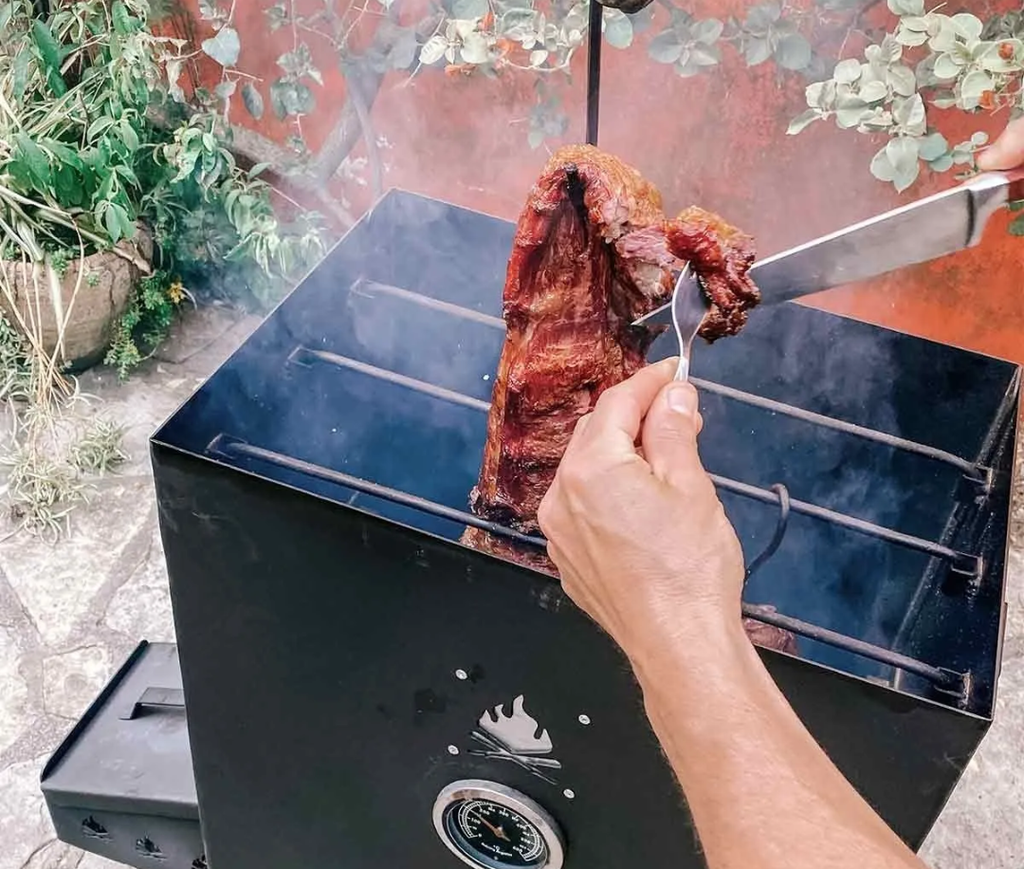
The process is as delightful as it is straightforward. Instead of tossing the wood into the fire, the Argentine grill master places it strategically beside the grill. As the wood smolders, it releases a gentle plume of fragrant smoke that mingles with the sizzling meat. It’s like the meat is enjoying a rejuvenating spa day, except the hot stones are replaced with smoldering wood, and the aromatherapy is courtesy of the enchanted forest.
This smoky infusion adds a layer of depth and complexity to your grilled delicacies, elevating them from everyday eats to culinary masterpieces. It’s the secret ingredient that makes your barbecue dishes memorable, and it’s almost as if your grill suddenly earned a Michelin star.
So next time you’re in Argentina or hosting a barbecue, consider these diverse techniques to take your grilling game to the next level and savor the essence of Argentine cuisine while sharing a laugh or two with friends and family.
So, You’ve got the grill fired up, and the meat is ready to sizzle. But hold your horses; what about the right grilling knives? Don’t fret; we’ve got you covered. In this article, we will review the best Grilling Knives for a true authentic Argentine Asado!
You know that in this game, the knife isn’t just a tool; it’s your trusty sidekick, your culinary companion, and sometimes, your secret weapon. Without the right knife, you’d be butchering the beauty of an Asado, and not in a good way!
Now, before you dash to your local store, or, let’s be real, start scrolling through an endless abyss of online shopping options, there are a few things to consider. It’s not about having a drawer full of knives; it’s about having the right one that makes you feel like a true maestro of the parrilla.

First things first – the blade. It’s a make-or-break choice, much like picking the perfect steak. Do you go serrated or smooth? The serrated edge is like the wild, unruly hair of the knife world, with those jagged teeth, great for sawing through bread but as out of place at an Asado as a penguin in a desert.
What you want is a smooth operator. Why? Because the Asado is all about sliding that blade through your succulent creations. Picture this: slicing into a perfectly grilled steak, gently cutting provoleta, or even gracefully carving a sausage. The smooth edge grants you control, precision, and the art of a perfect cut. Plus, it’s easier to sharpen than its serrated cousin.
Leave the serrated edge for the toast and pineapple; your Asado deserves nothing less than smooth excellence.
Once you’ve decided on the smooth edge, it’s time to find “The One.” A grill knife should feel like an extension of your arm, not some awkward appendage. Here are a few things to consider when hunting for your perfect match:
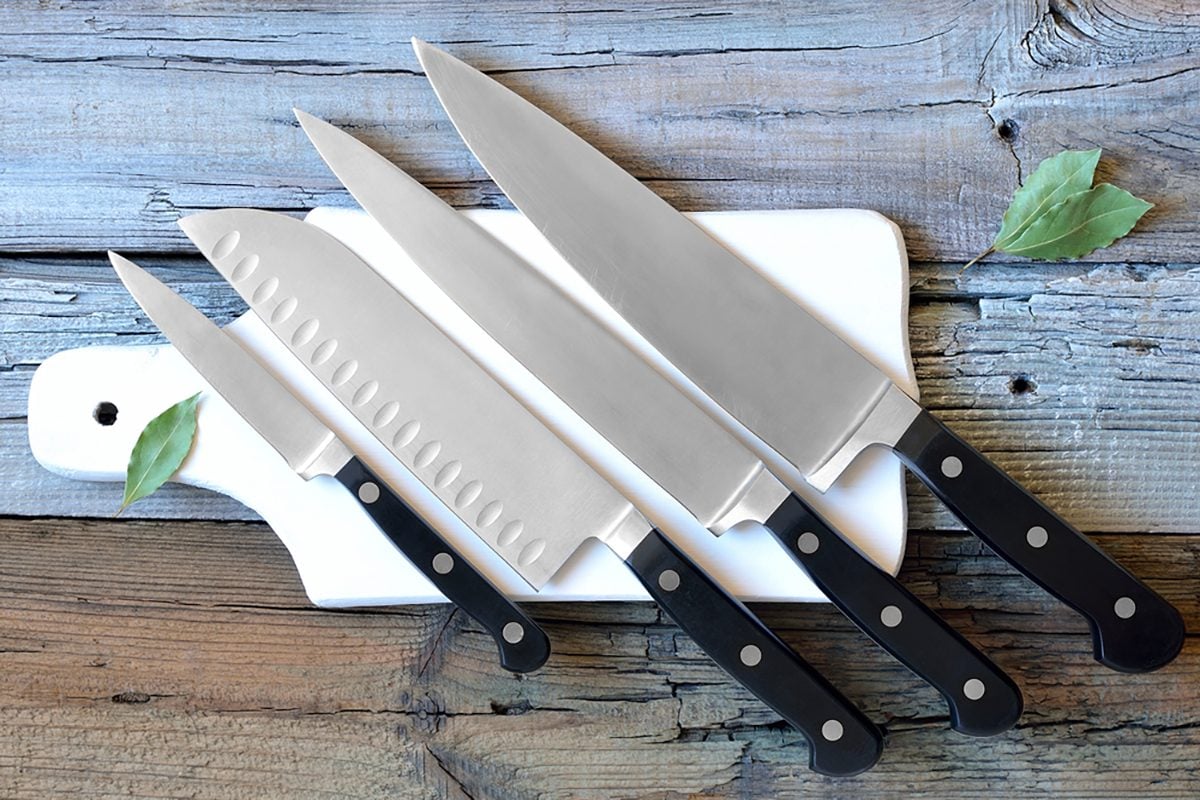
You’ve got the smooth edge, and you’ve met “The One,” but what’s “The One” made of? Knives these days are all about stainless steel, but not all stainless steel is created equal. Here’s a quick rundown:
In the world of artisanal knives in Argentina, there’s a fierce debate that rivals the passion of a Boca Juniors vs. River Plate match. It’s the showdown between carbon steel and stainless steel – the ultimate face-off for choosing the right blade.
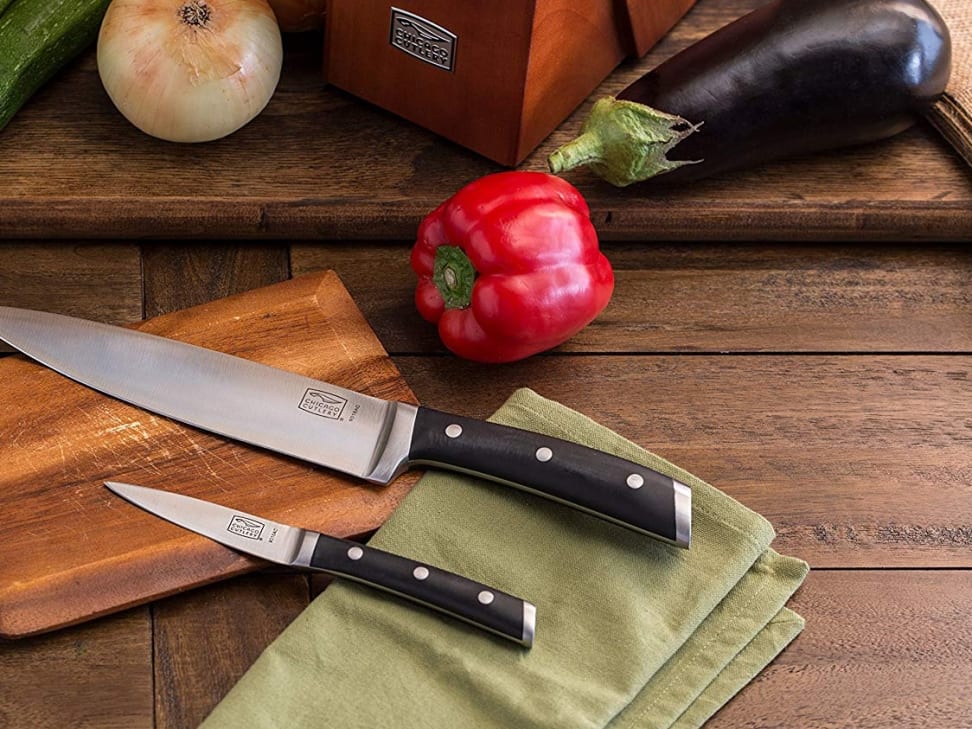
Stainless steel is like that friend who’s always laid-back, never asking for much. It’s known for its resistance to corrosion, making it the ideal choice if you’re the type who throws your knives in the dishwasher and forgets about them. It won’t complain about rust, and it’s less likely to get stained compared to its carbon counterpart. Plus, it’s built to last, enduring the test of time like a seasoned asador mastering the grill.
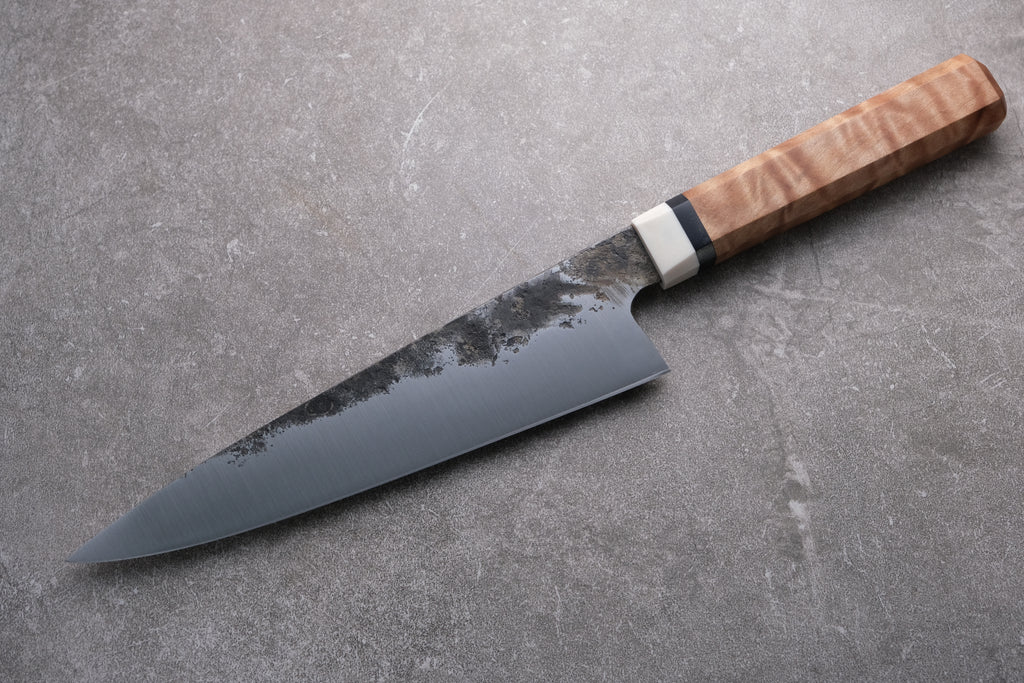
On the other side of the parrilla, we have carbon steel – the maestro of sharpness. It can hold a blade edge like a tango dancer holding a pose. If you seek precision and silky-smooth cuts, this is your go-to steel. But, here’s the twist – it’s a diva. Carbon steel needs a bit of pampering. It’s like that demanding artist who insists on a specific green room temperature. It’s more prone to corrosion, so you’ll have to clean and dry it carefully after every use to avoid that dreaded rust tango.
So, which steel is the true champion for your artisanal Argentine knives? The answer, much like a controversial Maradona vs. Messi debate, depends on your personal preferences and how you’ll use your knives.
If you value low maintenance and corrosion resistance, stainless steel takes the trophy. It’s your partner in crime when you want to focus on the sizzle, not the cleanup.
But if you prioritize a razor-sharp edge that can cut through meat like a hot knife through butter and you’re willing to put in a little extra TLC, then carbon steel is the right match for you.
It’s not just about the steel; it’s about the love and care you put into your craft, whether it’s grilling or choosing the perfect knife. So, pick your steel and start slicing your way to culinary greatness. Just like in football (soccer), there’s no one-size-fits-all answer – it’s about the game you want to play.
Remember, your knife is not just a tool; it’s an extension of your personality and grilling style. Pick the one that suits you best and show off your skills on the parrilla. Buen provecho, and may your Asado be forever sizzling!
If you thought you knew everything about BBQ, think again! In this article, I’d like to present you with Argentine Asado, which isn’t just a way to cook meat: it’s a cultural ritual that brings people together. I’ll explore the distinctive qualities that make asado different from the traditional BBQ in your backyard barbecue experience, delving into the cultural aspects that make it a culinary phenomenon worth understanding and appreciating.

Argentine Asado is deeply rooted in the culture of the country due to its origins, intertwined with the nomadic lifestyle of the gauchos (who would gather around open fires during their journeys across the plains) and the traditions of the indigenous people who have been living there for hundreds of years.
Today, preparing an asado is not merely a method of cooking; it is a cultural institution. The tradition of gathering around a fire to cook and share meat fosters a sense of camaraderie and celebration. Plus, the art of preparing asado passes down from generation to generation to preserve its authenticity and techniques.
In contrast, the origins of barbecue in the United States are often associated with the melding of European and Native American culinary techniques. Barbecue in the U.S. evolved as a fusion of indigenous slow-cooking methods and European spicing and smoking traditions. Over time, it developed distinct regional styles, such as the vinegar-based sauces of the Carolinas or the tomato-based sauces of Kansas City.
Now, let’s take a look at the juiciest differences between barbecue and Argentine Asado: their meat selection. Renowned for its high-quality, grass-fed cattle, Asado has beef at its center. And certain cuts hold particular significance, such as a rack of ribs (known as asado de tira), brisket (vacío), and the delicious flank steak (or matambre) are popular choices.
Argentine Asado often involves minimal seasoning, allowing the natural flavors of the meat to shine. It’s more common to add sauces after the meat is cooked, like chimichurri or salsa criolla. Also, the experience would not be complete without achuras (organ meats), which give a whole new dimension to asados.
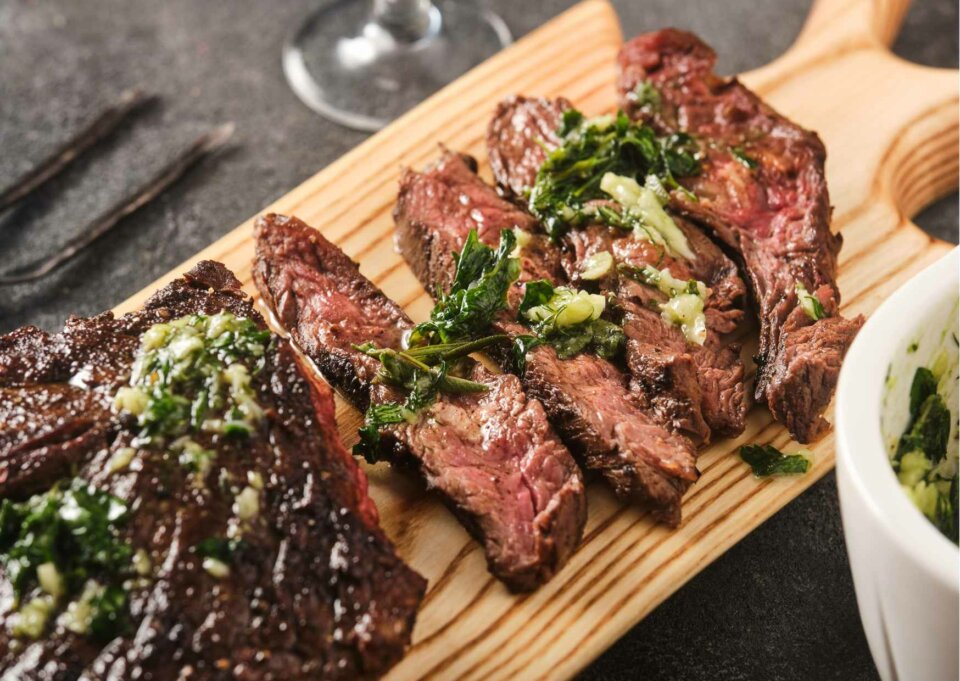
Achuras are different organs from the cow that are typically grilled before the actual beef, and here are five examples of achuras commonly used in Argentine asados:
Meanwhile, traditional barbecue in the United States is characterized by a more diverse selection of meats. While beef is still prominent, pork, chicken, and even lamb are commonly eaten, too. Each region has its preferred meat, leading to a rich tapestry of barbecue styles across the country.
Unlike the minimalistic approach of Argentine Asado, traditional barbecue often involves elaborate rubs, marinades, and sauces, with sweet and tangy barbecue sauces in the South, dry rubs in the Midwest, and vinegar-based sauces in the East.
And not everything is about the meat: what you use to grill your asado or barbecue will also make the difference. In the case of Argentine asado, the traditional parrilla is a crucial element of the experience.
Characterized by its open-flame design, this is a straightforward structure featuring an adjustable grate that allows for precise control over the distance between the meat and the flames. The spacious layout of the parrilla allows people to simultaneously grill different cuts and achuras. What sets this grill apart is the predominant use of hardwoods like quebracho as the primary fuel source. The idea is to use wood with slow-burning properties that can impart a unique smokiness to the meat.
When it comes to barbecue, grilling techniques and equipment vary widely, reflecting regional preferences and modern conveniences. Charcoal grills, akin to the traditional parrilla, maintain an open-flame approach, providing an authentic grilling experience. You can also use gas grills (sacrilege for an Argentinian asador!) because of their convenience and precise temperature control.
While lacking the traditional smokiness of wood or charcoal, modern barbecue enthusiasts often employ wood chips or pellets in conjunction with these grills to infuse a smoky flavor into the meat. Additionally, dedicated smokers, equipped with smoker boxes for wood chips or chunks, offer prolonged exposure to smoke during the cooking process.

Argentine Asado prides itself on the simplicity of seasoning, letting the quality of the meat shine through. If you were to prepare an asado, you would use no more than salt, pepper, and, on occasion, a touch of lemon juice. But this doesn’t mean Argentinians don’t have delicious sauces to accompany asado. You can try out:
Barbecue, with its diverse regional styles, boasts an array of seasoning and marinade approaches. It involves soaking the meat in ingredients like soy sauce, Worcestershire sauce, herbs, and spices before grilling. Dry rubs, a blend of spices applied directly to the meat’s surface, are equally popular, forming a delicious crust during the cooking process.
Asado in Argentina is not just a method of cooking; it’s a social event deeply ingrained in the culture. Friends and family gather around the grill, creating a friendly atmosphere where the preparation of food is as significant as its consumption – everybody participates. For example, the parrillero, or grill master, holds a revered position as they are in charge of the grilling process, showcasing skill, and expertise.
While the parrillero grills the meat, the rest of the people will prepare accompaniments like chimichurri, salads, and bread to be shared among the guests. Additionally, the act of sharing a bottle of wine, often a Malbec, further enhances the social ambiance, with toasts and conversations flowing freely. Plus, it’s common for asados to last forever, starting early in the morning and finishing around the evening.
Barbecue traditions in the United States also emphasize social gatherings, whether it’s a backyard barbecue, a tailgate party, or a large-scale event. The atmosphere is usually more laid-back and the event itself is shorter than an asado.
In American barbecue, various types of meat are commonly grilled or smoked, and the specific type of meat can vary by region.
All in all, while both Argentine asado and traditional barbecue share the common thread of grilling meat, their historical roots diverge, resulting in unique approaches to cuts of meat, seasoning, and devices with which to grill. Most importantly, they hold different cultural significance: Argentine asado remains a symbol of the rugged, outdoor lifestyle of the gauchos, creating a culinary identity deeply connected to the Argentine way of life.
The barbecue world has unique flavors that set it apart from other cooking methods, but not everything is about BBQ itself. From the sizzling and fast grilling to the slow smokers and the cultural richness of Argentine asado, in this BBQ guide, I’d like to discuss the difference between your traditional BBQ and other equally great cooking methods that give meat the most delicious flavor. Who knows, perhaps soon you’ll find yourself cooking some achuras over an Argentinian grill!
When it comes to backyard gatherings, BBQ and cookouts emerge as contenders. Picture a typical summer evening, the sun casting a warm glow on the backyard, and a group of friends or family eating outside. Is what they are doing it barbecue or cookout?
Geographical location plays a pivotal role in shaping the meanings of “barbecue” and “cookout.” In the Northeast and Midwest of the USA, these terms are often used interchangeably, referring to a gathering where friends and family grill hot dogs, hamburgers, and other summer favorites.
But the distinctions become more pronounced in the South, where a “cookout” signifies fast cooking over a direct flame, featuring fast food like hot dogs and hamburgers. On the other hand, a “barbecue” in Southern states involves a grander scale event, characterized by slow cooking over an indirect heating source, such as pits or smokers.
This method requires meticulous preparation of meat (which includes pork, chicken, and beef), including marinating meats overnight and slow-cooking them for hours. All in all, barbecues involve slow cooking in indirect heat, often planned well in advance, while cookouts are characterized by quicker, direct heat cooking and a more spontaneous gathering.

Now let’s delve into the difference between BBQ vs grilling. Barbecuing entails slow-cooking large cuts of meat over an indirect heat source, commonly using charcoal or wood. The process, often characterized by a temperature range between 100 and 150°C, demands a significant time investment, with the goal of achieving tender, flavorful results. This method is ideal for tougher cuts like:
The idea is to eat meat that is soft, moist, and infused with a distinct barbecue flavor.
Meanwhile, grilling is more like an action movie, as you’ll be cooking foods hot and fast (typically around 230 – 290°C) over direct heat. Dinner is served in less time than it takes to decide what to watch on a streaming service! This means you cannot really grill anything, but you’ll need small cuts of food that take less than 20 minutes to cook, such as:
Grilling is versatile and suitable for a variety of foods, including vegetables and fruits, making it a popular choice for providing a diverse range of dishes, including those suitable for vegetarian and vegan diets.
This comparison is even more difficult and your taste buds will be the ultimate judges. While barbecue requires a temperature dance between 100 and 150°C, ensuring the meat emerges tender, the smoker uses hot charcoal and slow-burning hardwood to envelop meats in aromatic wood smoke.
Smoking is typically done at lower temperatures, often ranging from 82 to 135°C and using different types of wood, such as hickory, mesquite, or fruitwoods, that can give unique flavors to the smoked meat. Just consider that smoking is not for the faint-hearted or the impatient: some recipes call for 24 hours of smoking time —yes, you read that right!
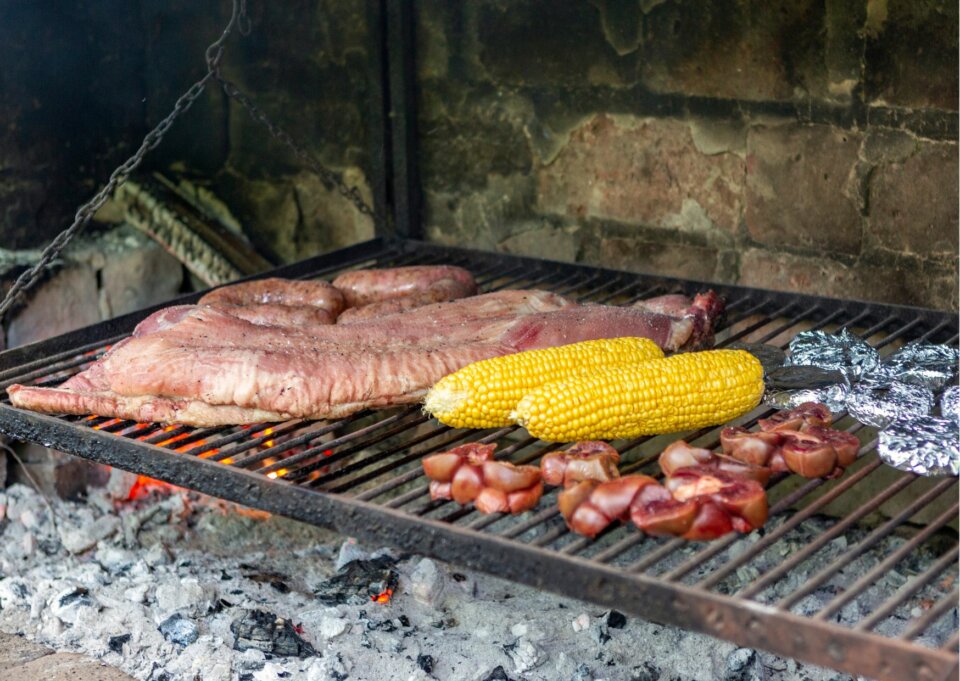
Now comes the ultimate duel in the art of cooking meat with hot charcoal: what’s the difference between barbecue and Argentine Asado? While both BBQ and Argentine Asado share the common denominator of grilling meat, they diverge in the details.
The Argentine Asado is not just a meal; it’s a sacred ritual that takes place every weekend, on birthdays, during Christmas, before or after important football matches, or, to be honest, whenever possible. It involves friends and family, who gather around the fire as a whole social event that takes hours to prepare and enjoy.
The first crucial step in mastering the Argentine Asado is building the fire, a task that demands respect for tradition and a bit of finesse. Asadores, the designated grill masters, understand that the fire’s quality directly influences the flavor of the meat. So, they typically use hardwoods like quebracho, carbón made of wood, and even piquillinto strike the perfect balance of embers and flames. A good asador would never use starters or lighter fluid to accelerate the process: instead, they shovel brasas under the grill. In contrast, in the US many grills are powered by gas or electricity.
This fire-starting ritual takes a long time, so preparing an asado can be a lengthy process: you would spend 3-4 hours preparing everything. Because it’s not just steak you would prepare in an Argentine Asado, as many times happens in an American barbecue: achuras are served and enjoyed first. Some examples include:
After these achuras, Argentinians enjoy different cuts of meat like whole racks of ribs, flank steak, brisket, and even vegetables like potatoes or bell peppers. Special asados, like the ones that take place during someone’s birthday, can start at around 9 am and end at night, so get ready for an intense experience. And if you ever meet an Argentinian, don’t you dare suggest using a gas barbecue to prepare asado – you will surely offend them!
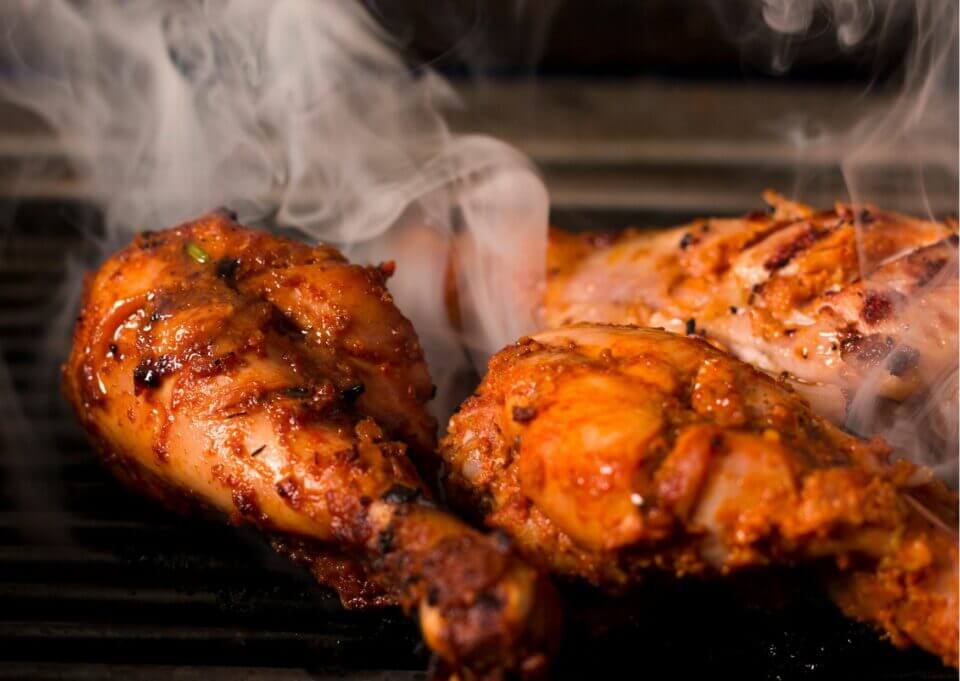
Barbecue and Tandoori, while both centered around the art of cooking meat, also come from different culinary realms. While Barbecue, a heavyweight in the American culinary landscape, involves slow-cooking meat over an open flame, Tandoori is the star of Indian cuisine and has a different method.
When using the Tandoori method, you’ll be marinating meats in a mixture of yogurt and spices, including garam masala and turmeric, before cooking them in a tandoor (a clay oven). The intense heat of the tandoor gives a delicious smokiness to the meat, creating an aromatic, earthy flavor that is also rich with spices.
So, barbecue relies on slow cooking over indirect heat, allowing the meat to absorb smoky nuances over an extended period of time. In contrast, Tandoori embraces high-heat, rapid cooking, resulting in the searing of spices into the meat and creating a unique crust – spices play a big role in ensuring food is tasty.
As smoke curtains descend on this BBQ guide, I’d like to emphasize that all of these cooking methods offer something unique. From the slow-cooked steaks of BBQ to the whole Argentine asado experience, you’ll discover whole new ways to cook your meat and even transform your backyard into a stage for a culinary ritual, and, who knows, new techniques that will make your beef even more tasty.
 What's in it for You Every Month on Saturday?
What's in it for You Every Month on Saturday? Special Bonus: Sign up now and get a FREE guide: "5 Secrets to Perfect Asado Every Time"
Special Bonus: Sign up now and get a FREE guide: "5 Secrets to Perfect Asado Every Time"